J Korean Med Assoc.
2018 Jul;61(7):416-425. 10.5124/jkma.2018.61.7.416.
Up-to-date knowledge on age-related macular degeneration
- Affiliations
-
- 1Department of Ophthalmology, Kangdong Sacred Heart Hospital, Hallym University College of Medicine, Seoul, Korea. eyepyo@gmail.com
- KMID: 2416412
- DOI: http://doi.org/10.5124/jkma.2018.61.7.416
Abstract
- Age-related macular degeneration (AMD) is a major cause of central vision loss in developed countries. The incidence of AMD has increased rapidly in Korea. The objective of this article is to introduce the latest knowledge about the pathophysiology, diagnostic tools and therapeutic modalities of AMD. The risk factors for AMD are age, smoking, familial history, genetic factors related to the complement system, diet, and cholesterol levels. Inflammation plays an important role in the pathophysiology of AMD and is associated with the complement system. Genes associated with the complement system affect the pathophysiology, expression, progression and therapeutic response of AMD. The use of antioxidants, zinc, and omega-3 fatty acids inhibits progression from moderate AMD to advanced AMD. Although there is no established treatment for dry AMD, treatment with agents that inhibit the complement system or through other mechanisms is under study. A number of anti-vascular endothelial growth factor agents have been developed for the prevention of choroidal neovascularization in the treatment of wet AMD and are being used clinically. Therapeutic alternatives to anti-vascular endothelial growth factor agents are under study.
MeSH Terms
-
Antioxidants
Cholesterol
Choroidal Neovascularization
Complement System Proteins
Developed Countries
Diet
Endothelial Growth Factors
Fatty Acids, Omega-3
Incidence
Inflammation
Korea
Macular Degeneration*
Risk Factors
Smoke
Smoking
Vascular Endothelial Growth Factor A
Zinc
Antioxidants
Cholesterol
Complement System Proteins
Endothelial Growth Factors
Fatty Acids, Omega-3
Smoke
Vascular Endothelial Growth Factor A
Zinc
Figure
Reference
-
1. Tarallo V, Hirano Y, Gelfand BD, Dridi S, Kerur N, Kim Y, Cho WG, Kaneko H, Fowler BJ, Bogdanovich S, Albuquerque RJ, Hauswirth WW, Chiodo VA, Kugel JF, Goodrich JA, Ponicsan SL, Chaudhuri G, Murphy MP, Dunaief JL, Ambati BK, Ogura Y, Yoo JW, Lee DK, Provost P, Hinton DR, Nunez G, Baffi JZ, Kleinman ME, Ambati J. DICER1 loss and Alu RNA induce age-related macular degeneration via the NLRP3 inflammasome and MyD88. Cell. 2012; 149:847–859.
Article2. Johnson LV, Leitner WP, Staples MK, Anderson DH. Complement activation and inflammatory processes in Drusen formation and age related macular degeneration. Exp Eye Res. 2001; 73:887–896.
Article3. Nordgaard CL, Karunadharma PP, Feng X, Olsen TW, Ferrington DA. Mitochondrial proteomics of the retinal pigment epithelium at progressive stages of age-related macular degeneration. Invest Ophthalmol Vis Sci. 2008; 49:2848–2855.
Article4. Esparza-Gordillo J, Soria JM, Buil A, Almasy L, Blangero J, Fontcuberta J, Rodriguez de Córdoba S. Genetic and environmental factors influencing the human factor H plasma levels. Immunogenetics. 2004; 56:77–82.
Article5. van Asten F, Simmons M, Singhal A, Keenan TD, Ratnapriya R, Agron E, Clemons TE, Swaroop A, Lu Z, Chew EY; Age-Related Eye Disease Study 2 Research Group. A deep phenotype association study reveals specific phenotype associations with genetic variants in age-related macular degeneration: age-related eye disease study 2 (AREDS2) report no. 14. Ophthalmology. 2018; 125:559–568.
Article6. Smailhodzic D, Muether PS, Chen J, Kwestro A, Zhang AY, Omar A, Van de Ven JP, Keunen JE, Kirchhof B, Hoyng CB, Klevering BJ, Koenekoop RK, Fauser S, den Hollander AI. Cumulative effect of risk alleles in CFH, ARMS2, and VEGFA on the response to ranibizumab treatment in age-related macular degeneration. Ophthalmology. 2012; 119:2304–2311.
Article7. Medina FM, Alves Lopes da Motta A, Takahashi WY, Carricondo PC, Dos Santos Motta MM, Melo MB, Vasconcellos JP. Pharmacogenetic Effect of complement factor H gene polymorphism in response to the initial intravitreal injection of bevacizumab for wet age-related macular degeneration. Ophthalmic Res. 2015; 54:169–174.
Article8. Kim EK, Kim H, Vijayakumar A, Kwon O, Chang N. Associations between fruit and vegetable, and antioxidant nutrient intake and age-related macular degeneration by smoking status in elderly Korean men. Nutr J. 2017; 16:77.
Article9. Kim EK, Kim H, Kwon O, Chang N. Associations between fruits, vegetables, vitamin A, β-carotene and flavonol dietary intake, and age-related macular degeneration in elderly women in Korea: the Fifth Korea National Health and Nutrition Examination Survey. Eur J Clin Nutr. 2018; 72:161–167.
Article10. Saunier V, Merle BMJ, Delyfer MN, Cougnard-Gregoire A, Rougier MB, Amouyel P, Lambert JC, Dartigues JF, Korobelnik JF, Delcourt C. Incidence of and risk factors associated with age-related macular degeneration: four-year follow-up from the ALIENOR study. JAMA Ophthalmol. 2018; 136:473–481.
Article11. Cougnard-Gregoire A, Delyfer MN, Korobelnik JF, Rougier MB, Malet F, Le Goff M, Dartigues JF, Colin J, Barberger-Gateau P, Delcourt C. Long-term blood pressure and age-related macular degeneration: the ALIENOR study. Invest Ophthalmol Vis Sci. 2013; 54:1905–1912.
Article12. Zhu W, Wu Y, Xu D, Li YH, Jun B, Zhang XL, Wang F, Yu J. Aspirin use and risk of age-related macular degeneration: a meta-analysis. PLoS One. 2013; 8:e58821.
Article13. Batioglu F, Gedik Oguz Y, Demirel S, Ozmert E. Geographic atrophy progression in eyes with age-related macular degeneration: role of fundus autofluorescence patterns, fellow eye and baseline atrophy area. Ophthalmic Res. 2014; 52:53–59.
Article14. Goldstein M, Loewenstein A, Barak A, Pollack A, Bukelman A, Katz H, Springer A, Schachat AP, Bressler NM, Bressler SB, Cooney MJ, Alster Y, Rafaeli O, Malach R; Preferential Hyperacuity Perimeter Research Group. Results of a multicenter clinical trial to evaluate the preferential hyperacuity perimeter for detection of age-related macular degeneration. Retina. 2005; 25:296–303.
Article15. Jackson GR, Scott IU, Kim IK, Quillen DA, Iannaccone A, Edwards JG. Diagnostic sensitivity and specificity of dark adaptometry for detection of age-related macular degeneration. Invest Ophthalmol Vis Sci. 2014; 55:1427–1431.
Article16. Rhoades W, Dickson D, Do DV. Potential role of lampalizumab for treatment of geographic atrophy. Clin Ophthalmol. 2015; 9:1049–1056.17. Tsai JC. Canadian Journal of Ophthalmology Lecture: translational research advances in glaucoma neuroprotection. Can J Ophthalmol. 2013; 48:141–145.
Article18. Wong WT, Kam W, Cunningham D, Harrington M, Hammel K, Meyerle CB, Cukras C, Chew EY, Sadda SR, Ferris FL. Treatment of geographic atrophy by the topical administration of OT-551: results of a phase II clinical trial. Invest Ophthalmol Vis Sci. 2010; 51:6131–6139.
Article19. Schwartz SD, Regillo CD, Lam BL, Eliott D, Rosenfeld PJ, Gregori NZ, Hubschman JP, Davis JL, Heilwell G, Spirn M, Maguire J, Gay R, Bateman J, Ostrick RM, Morris D, Vincent M, Anglade E, Del Priore LV, Lanza R. Human embryonic stem cell-derived retinal pigment epithelium in patients with age-related macular degeneration and Stargardt's macular dystrophy: follow-up of two open-label phase 1/2 studies. Lancet. 2015; 385:509–516.
Article20. Kumar N, Marsiglia M, Mrejen S, Fung AT, Slakter J, Soren-son J, Freund KB. Visual and anatomical outcomes of intra-vitreal aflibercept in eyes with persistent subfoveal fluid despite previous treatments with ranibizumab in patients with neovascular age-related macular degeneration. Retina. 2013; 33:1605–1612.
Article21. Bakall B, Folk JC, Boldt HC, Sohn EH, Stone EM, Russell SR, Mahajan VB. Aflibercept therapy for exudative age-related macular degeneration resistant to bevacizumab and ranibizumab. Am J Ophthalmol. 2013; 156:15–22.
Article22. Cho H, Shah CP, Weber M, Heier JS. Aflibercept for exudative AMD with persistent fluid on ranibizumab and/or bevacizumab. Br J Ophthalmol. 2013; 97:1032–1035.
Article23. Ho VY, Yeh S, Olsen TW, Bergstrom CS, Yan J, Cribbs BE, Hubbard GB 3rd. Short-term outcomes of aflibercept for neovascular age-related macular degeneration in eyes previously treated with other vascular endothelial growth factor inhibi-tors. Am J Ophthalmol. 2013; 156:23–28.
Article24. Blanco-Garavito R, Jung C, Uzzan J, Quaranta-ElMaftouhi M, Coscas F, Sahel J, Korobelnik JF, Bechet S, Querques G, Souied EH. Aflibercept after ranibizumab intravitreal injections in exudative age-related macular degeneration: the ARI2 study. Retina. 2017; 12. 21. [Epub]. DOI: 10.1097/IAE.0000000000001928.25. Kim JH, Cho NC, Kim WJ. Intravitreal aflibercept for neovascular age-related macular degeneration resistant to bevacizumab and ranibizumab. J Korean Ophthalmol Soc. 2015; 56:1359–1364.
Article26. Kim KM, Kim JH, Chang YS, Kim JW, Kim CG, Lee DW. Efficacy of three aflibercept injections for neovascular age-related macular degeneration showing limited response to ranibizumab. J Korean Ophthalmol Soc. 2017; 58:62–68.
Article27. Moon DR, Lee DK, Kim SH, You YS, Kwon OW. Aflibercept treatment for neovascular age-related macular degeneration and polypoidal choroidal vasculopathy refractory to anti-vascular endothelial growth factor. Korean J Ophthalmol. 2015; 29:226–232.
Article28. Heier JS, Kherani S, Desai S, Dugel P, Kaushal S, Cheng SH, Delacono C, Purvis A, Richards S, Le-Halpere A, Connelly J, Wadsworth SC, Varona R, Buggage R, Scaria A, Campochiaro PA. Intravitreous injection of AAV2-sFLT01 in patients with advanced neovascular age-related macular degeneration: a phase 1, open-label trial. Lancet. 2017; 390:50–61.
Article29. Soderberg AC, Algvere PV, Hengstler JC, Soderberg P, Seregard S, Kvanta A. Combination therapy with low-dose transpupillary thermotherapy and intravitreal ranibizumab for neovascular age-related macular degeneration: a 24-month prospective randomised clinical study. Br J Ophthalmol. 2012; 96:714–718.
Article30. Ranjbar M, Kurz M, Holzhey A, Melchert C, Rades D, Grisanti S. Stereotactic radiotherapy in neovascular age-related macular degeneration: real-life efficacy and morphological evaluation of the outer retina-choroid complex. Medicine (Baltimore). 2016; 95:e5729.31. da Cruz L, Fynes K, Georgiadis O, Kerby J, Luo YH, Ahmado A, Vernon A, Daniels JT, Nommiste B, Hasan SM, Gooljar SB, Carr AF, Vugler A, Ramsden CM, Bictash M, Fenster M, Steer J, Harbinson T, Wilbrey A, Tufail A, Feng G, Whitlock M, Robson AG, Holder GE, Sagoo MS, Loudon PT, Whiting P, Coffey PJ. Phase 1 clinical study of an embryonic stem cell-derived retinal pigment epithelium patch in age-related macular degeneration. Nat Biotechnol. 2018; 36:328–337.
Article
- Full Text Links
- Actions
-
Cited
- CITED
-
- Close
- Share
- Similar articles
-
- Factors Associated with Senile Macular Degeneration in Elders within Communities
- Radiotherapy for Age-related Macular Degeneration Associated with Subfoveal Neovascular Membrane
- Hereditary Macular Degeneration which Involved A Brother and Sister of One Family
- Association between Ranibizumab Injections and Risk of Acute Myocardial Infarction in Age-related Macular Degeneration: A Case-crossover Study
- Human Bruch's Membrane: Regional and Age-Related Alterations



